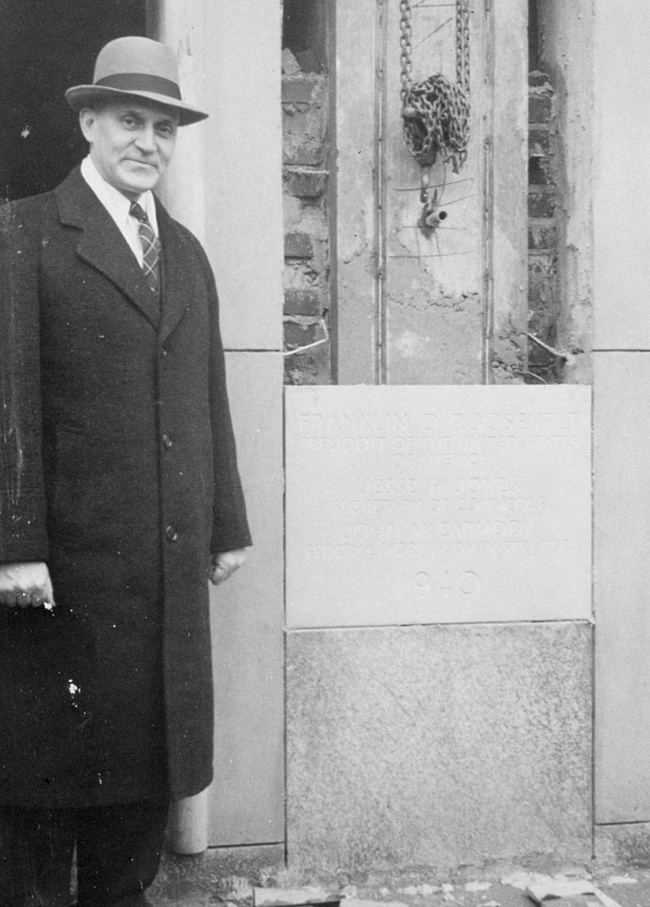Name Francis Reichelderfer Died 1983 | ||
 | ||
Francis Wilton Reichelderfer (August 6, 1895 – January 26, 1983), also known as “Reich”, presided over a revolutionary era in the history of the Weather Bureau. From 1938 to 1963, Reich guided the organization through World War II and brought modern technology to weather forecasting. His greatest strengths were comprehending where meteorology should be going, acting to move in that direction, and then attracting and keeping the talent to make it happen.
Contents
Early history
Francis was born in Harlan, Indiana in 1895, the son of a Methodist minister. He worked his way through college, rising at 3:30 a.m. to stoke the furnaces and wait tables in a women’s dormitory. He did not even begin his career as a meteorologist, graduating in 1916 from Northwestern University with a degree in chemical engineering.
Navy service
Francis began a series of experiences and career appointments in the U.S. Navy. During World War I, he became a naval reserve officer in 1916 and was selected for the first class of military personnel for training at the Massachusetts Institute of Technology meteorological school. Afterwards, he was assigned as naval aerographer (a Navy term for meteorologist) and sent to Nova Scotia to brief submarine patrol pilots on weather conditions.
But “Reich” was a man of action and volunteered to become a naval aviator. As such, he not only thought about observing and forecasting the weather, but also realized that understanding it was a matter of life and death for the aviation community. He flew in dirigibles, fixed wing aircraft, and even as a competitive hot air balloonist. Because of his meteorological and aviation experience, he became Chief of Navy Aerology in 1922 and served in that capacity until 1928. He worked in a corner of the main Weather Bureau offices in Washington, D.C., drawing up maps, comparing them to official forecasts, and pondering the weather.
The Norwegian Bergen School of Meteorology attracted his attention, and soon Reichelderfer became one of the first American meteorologists to espouse its approach to predicting weather. This approach relied on physical principles for analyzing weather fronts and air masses and not simply weather observations. The Navy assigned Reichelderfer to Bergen, Norway, in 1931 for further studies in air mass and frontal analysis. Following this assignment, he had a tour of duty at sea on the battleship Oklahoma, then back to the Navy dirigible service, and finally to sea as executive officer of the battleship Utah.
During this period, Reichelderfer made many influential friends. Among them were Carl Gustav Rossby, a Swedish meteorologist who recently moved to the U.S.; Harry Guggenheim, who funded Rossby to develop the first weather observation and forecast system for aviation in California in the late 1920s; Alexander McAdie of Harvard’s Blue Hill Observatory; and Robert Millikan, president of California Institute of Technology. These men would later be instrumental in Reichelderfer’s appointment to lead the Weather Bureau.
In September 1938, Willis Gregg, then head of the Weather Bureau, died suddenly from a heart attack. Because of his knowledge of aviation meteorology, possibly his military background (World War II loomed on the horizon), and his familiarity with Bergen methods of weather forecasting, Reichelderfer’s influential colleagues successfully championed him to head the Weather Bureau. After 22 years in the United States Navy, he retired from a first career and began moving the Weather Service into the future.
Weather Bureau history
Reichelderfer began his tenure as Weather Bureau Chief on December 15, 1938. He surrounded himself with scientifically minded individuals such as Carl Rossby, Harry Wexler, and Horace Byers and began pushing the Bureau towards the Bergen methods of forecasting. Soon, however, the Weather Bureau was immersed in World War II. With his naval aerology, shipboard, and aviation experiences, “Reich” was the ideal leader to guide the Weather Bureau through its wartime mobilization.
He grasped the need for worldwide weather services, helped institute wartime training for hundreds of meteorologists, recruited hundreds of women to replace the men who had entered the armed services, and served on the Joint Meteorological Committee composed of himself and the heads of the Army and Navy weather services. National leaders now viewed weather forecasting, possibly for the first time, as a worldwide strategic imperative affecting the movements of vast numbers of men and amounts of material.
Reichelderfer quickly grasped the importance of technological advances and soon pursued radar as a weather observation and forecast tool. He advanced the study of climatology by overseeing the production of a forty-year series of carefully analyzed surface maps that showed weather patterns dating back to 1899. These aided World War II forecasts and also served as research guides. During the war years he also established an Air Mass and Frontal Analysis Center, which served as a model for other nations' weather services in the years following the war. After the war, “Reich” continued pressing forward, always on the lookout for new methods and new ideas. Continuing advances in radar meteorology, the introduction of computerized numerical weather prediction, and the development of a research arm studying such diverse topics as cloud seeding, severe storms, and patterns of radioactive material dispersal all happened during “Reich’s reign” throughout the 1950s. So did the beginnings of hurricane research programs, the Aircraft Operations Center, the National Severe Storms Laboratory, and the Air Resources Laboratory. Perhaps the greatest of weather observation innovations, the meteorological satellite, was also introduced during his tenure with the launch of TIROS I on April 1, 1960.
Francis Reichelderfer was a sailor, aviator, meteorologist, visionary, and administrator. He was instrumental in making important changes in the Weather Bureau through his ability to guide the organization; work with, encourage, and direct talented individuals; and work within the military and political systems of the U.S. and international bodies. His influence transcended the national boundaries as he helped form the World Meteorological Organization and served as its first president in 1951. He was awarded their International Meteorological Organization Prize in 1964,
